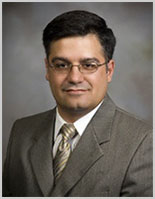PROFESSOR Q&As

Pablo Sobrado, an associate professor of biochemistry in the College of Agriculture and Life Sciences, studies human pathogens that cause a variety of diseases, including Chagas disease, tuberculosis, and various fungal infections. Because these diseases are estimated to affect millions in tropical regions, Sobrado is working to develop cost-effective drugs to improve the health and well-being of citizens in some of the neediest corners of the globe. For his work, Sobrado was awarded the National Technology Prize from the Costa Rican government, the country's highest scientific honor. He is a founding member of the Drug Discovery Consortium for Chagas Disease and the Virginia Tech Center for Drug Discovery.
I have always been a curious person, which is a common or perhaps a required characteristic of scientists. In high school, I was amazed by how well the chemical mechanism of some enzymes was understood. I was interested in learning how scientists were able to understand how enzymes function. The results from enzyme/drug discovery research have the possibility of improving the quality of life for many people around the world.
That has to be the journey from knowing very little about enzymes and how they function to understanding how they work at the atomic level. Our results have led to breakthroughs in the identification of enzyme inhibitors, which are molecules that block the activity of the enzyme.
Due to the migration of millions of people from endemic areas in Mexico and Central and South America, it is estimated that more than 200,000 people infected with the T. cruzi parasite—the parasite that causes Chagas disease—live in the United States, including Virginia. New cases are also expected from transfusions of blood containing the parasite. Therefore, finding a cure is urgently needed.
Our work has revealed the structure and mechanism-of-action of an enzyme called UDP-galactopyranose mutase, or UGM. Simply put, the enzyme provides the "blueprint" that can be used to accelerate the development of new drugs.
I believe that the major advance will come from computational biology. With this, we will be able to design from scratch an enzyme with a desired function. Similarly, computational biology will accurately predict the potential role of a compound as an inhibitor or as a substrate for a particular enzyme.
The major obstacle is development of drug resistance. As we embark into a drug discovery program, we need to be aware of selecting drug targets that have low potential for developing drug resistance.
Wu Feng is a professor and the Elizabeth and James Turner Fellow in the Department of Computer Science, as well as a professor with the Bradley Department of Electrical and Computer Engineering. His research focuses on the intersection of computer architecture, systems software and tools, middleware, and applications. Best known for his research in energy-efficient parallel computing, Feng was named a 2014 Outstanding Faculty Award winner by the State Council of Higher Education for Virginia.
My father purchased a Radio Shack Color TRS-80 in 1978, when I was 12 years old. I spent the summer immersed in learning how to make the computer do what I wanted it to do. I combed through two computer manuals and taught myself a new "foreign" language called BASIC. I tackled a wide range of prescribed problems from the manuals, ranging from the pragmatic—creating a bank account simulation with deposits, withdrawals, and balance queries—to the more frivolous: playing a tic-tac-toe game. While each problem required different logical reasoning and thinking, tic-tac-toe afforded me the most intellectually stimulating challenge, as I had to create an automated computer player that could consistently win a game of tic-tac-toe against a human. I finished the summer of 1978 with a simultaneous sense of empowerment and bewilderment.
If I was to go on a holy grail quest for the ideal supercomputer—which will likely not exist in my lifetime—it would be a supercomputer with zero carbon footprint, one that generates its own power and does not require extravagant power and cooling facilities.
Much of my inspiration and ideas come when I am outside the office. I often visit other academic environments on campus, which helps me understand how fundamental computer science concepts may be recast and applied in other disciplines. On the Drillfield, I throw a Frisbee or football with lab members and play Ultimate Frisbee in collegiate leagues, which relaxes my mind to be more receptive to new avenues of research. I teach STEM and computing to my children and their friends and classmates. This unconsciously forces me to think about new and more accessible ways to teach at their level.
Folks should view cloud computing much as they view electricity. One is a computing utility, while the other is an electrical utility. We do not think twice about turning on a light switch and drawing electricity from an electrical substation. Cloud computing is effectively drawing computing from a data center. Why the interest in our research on data-intensive biocomputing or, more generally, "big data" problems in the cloud? We are escalating the application and use of this computing utility that we call the cloud to solve significant scientific problems on a large scale. We are conducting the research necessary to create biocomputing tools, applications, and environments for the cloud. This involves not only orchestrating and coordinating computer resources, but also memory, storage, and network resources in the cloud. Learn more ...
Editor's note: For more on the university's big data efforts, see "Fortune-telling and other uses of big data at Virginia Tech" in this edition.
Produced by University Relations